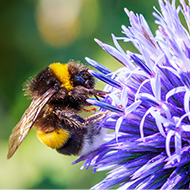
Colour is not the only thing used for identification.
Research carried out by the University of Exeter has found that honeybees can very effectively distinguish between different flowers using pattern as well as colour.
With their low-resolution vision, honeybees can only see the patterns on a flower clearly within a few centimetres.
However, the new study has found that bees usually consider pattern, suggesting that it is not just colour that leads them to flowers.
The research team tested bee behaviour and built bee's-eye-view simulations to understand how bees view flowers, and how they distinguish between them.
Professor Natalie Hempel de Ibarra, lead author on the study, explained: "We analysed a large amount of data on plants and bee behaviour.
"By training and testing bees using artificial patterns of shape and colour, we found they relied flexibly on their ability to see both of these elements.
"Showing how insects see colour and learn colour patterns is important to understand how pollinators may, or may not, create evolutionary 'pressures' on the colours and patterns that flowers have evolved.
"Our findings suggest that flowers don't need to evolve too many different petal colours, because they can use patterns to diversify their displays so bees can tell them apart from other flowers."
Entitled 'The role of colour patterns for the recognition of flowers by bees', the paper is available to read in Philosophical Transactions of the Royal Society B.



 FIVP has shared a survey, inviting those working in independent practice to share their views on the CMA's proposed remedies.
FIVP has shared a survey, inviting those working in independent practice to share their views on the CMA's proposed remedies.